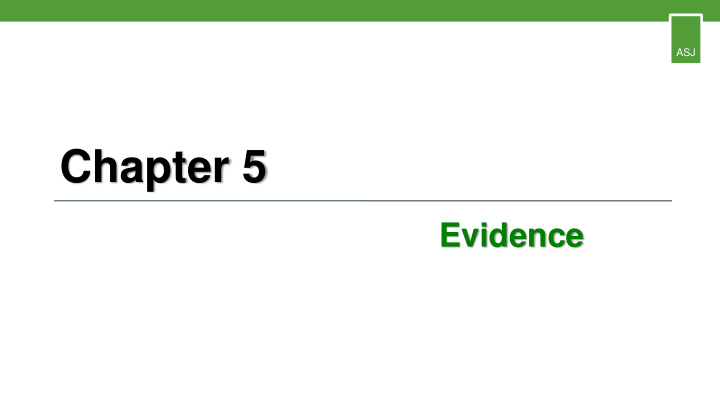



ASJ Chapter 5 Evidence
ASJ Stages of an Audit
Evidence and Auditor ASJ ISA 500 Audit evidence sets out the objective of the auditor as being to design and perform audit procedures in such a way to enable him to: obtain sufficient, appropriate audit evidence to be able to draw reasonable conclusions on which to base his audit opinion. • Sufficient relates to the quantity of evidence. • Appropriate relates to the quality relevance and reliability of the evidence.
Relevance ASJ Relevant • Relevance deals with the logical connection with, or bearing upon, the purpose of the audit procedure • A given set of audit procedures may provide audit evidence that is relevant to certain assertions, but not others. • Relevant audit evidence would include identifying conditions that indicate performance of a control, and deviation conditions. • Designing substantive procedures includes identifying conditions relevant to the purpose of the test that constitute a misstatement in the relevant assertion.
Relevance ASJ Reliability • Original is more reliable than Copy • Written is more reliable than Oral • Independent source is more reliable than through client • Auditor direct extraction of information is more reliable than through client • Obtained where controls are effective is more reliable than where controls is ineffective
Evidence and Auditor ASJ ISA 500 Audit evidence sets out the objective of the auditor as being to design and perform audit procedures in such a way to enable him to: obtain sufficient, appropriate audit evidence to be able to draw reasonable conclusions on which to base his audit opinion. • Sufficient relates to the quantity of evidence. • Appropriate relates to the quality relevance and reliability of the evidence. Relevant • Relevance deals with the logical connection with, or bearing upon, the purpose of the audit procedure
Audit Assertions – 4 Key Questions ASJ SN Questions Related to Elements Confirmation of Audit Assertions Related of Financial Statements. to Account Transactions Disclosures & Balances & Events Presentation 1 Existence Occurrence Should it be in the financial Right & Cut off statements at all? Obligation 2 Completeness Completeness Is there any more? 3 Allocation & Accuracy Is it taken at the right value? Valuation Classification 4 Understandability Is it properly presented or Completeness disclosed? Classification Accuracy & Valuation
ASJ Audit Assertions 1. Accounts Balance Existence Right & Obligations Completeness Valuation and allocation 2. Event and transactions Occurrence Completeness Accuracy Cut-off Classification 3. Disclosure and Presentation. Occurrence Completeness Classification and understandability Accuracy and valuation
RMM at assertion level ASJ At Assertion Level: Risk at assertion level are those which relate to specific objectives of the financial statements. Assertion Dictionary meaning - A confident statement of the fact or belief. ISAs definition – Representations (formal statements) by management, that are embodied (included) in the financial statements, as used by the auditor to consider the different type of potential misstatements that may occur. – ISAs definition simplified Claims by management regarding the appropriateness of the various elements of financial statements and disclosures.
ASJ How auditor extract evidence? Sources of audit evidence: Sources of Evidence Test of Substantive Controls Procedures Test of Analytical Details Procedures
ASJ Means of Getting Audit Evidence Analytical Review Enquiry & RepErformance Inspection (records as well as assets) Observation & COnfirmation RecalcUlation
ASJ Means of Getting Audit Evidence - Explained • Inspection . Obtain evidence about an item by going to look at it. • Observation . The auditor can obtain evidence by watching a procedure. • Inquiry . Evidence can be obtained by asking questions. • Confirmation. This is a specific type of enquiry where the auditor seeks confirmation from a party outside the entity, for example, from a bank or a customer. • Re-calculation. The auditor checks the arithmetical accuracy of documents or records. • Reperformance. The auditor re-performs a check or control originally carried out by the client. • Analytical procedures . These are ratios, trends, comparisons and other indirect approaches to analyzed data.
ASJ Sampling SAMPLING Using Random Not using random Selection / selection / Probability Theory Probability theory Statistical Non-Statistical
ASJ Detailed Presentation on Sampling ASC Dear Students We will move to separately designed presentation on Audit Sampling sampling. Supplement for my CAF 09 Students Compiled from ISAs and other resources by: Abdus Salam Jan - FCA
Recommend
More recommend